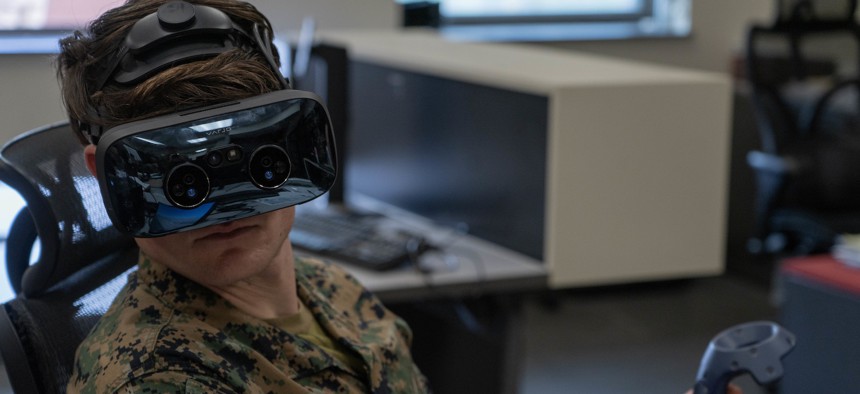
U.S. Marine Corps Sgt. Mason Whatley, a radio operator with 1st Air Naval Gunfire Liaison Company, I Marine Expeditionary Force Information Group, uses a Varjo XR-3 mixed reality headset during 1st ANGLICO certification exercise 2-23 at Marine Corps Base Camp Pendleton, California, Jan. 11, 2023. U.S. Marine Corps / Lance Cpl. Joseph Helms
Marines To Train For Future Battlefield With Immersive Technologies
The Marine Corps is revamping its training and education programs to prepare Marines to be problem solvers and decision makers, senior service officials say.
Training the next generation of Marines will require live and virtual environments to prepare them for a more complex battlefield, senior service officials said as the Marine Corps rolled out the newest piece of its Force Design 2030 effort.
The Force Design 2030 plan was presented by Commandant Gen. David Berger as a way to ready the Marine Corps for a future multi-domain fight, and the new 24-page document, Training and Education 2030 outlines how the service will change to prepare Marines for the “future operating environment.” The document includes 37 “directed actions” for changes and deliverables that span the next three years, as well as 17 items for further analysis.
“Our mission-essential task is essentially to produce cognitively capable, intuitive problem-solving Marines, who are really capable of operating in what we know is going to be that contested complex environment of the future. And be able to make decisions in that environment,” Lt. Gen. Kevin Iiams, the commanding general of the Marine Corps’ Training and Education Command, told reporters at the Pentagon ahead of the document’s release.
One new program in the Marine Corps’ multi-domain training and education effort is Project Tripoli, which will provide a “live, virtual, and constructive training environment” for all Marines unit levels, Iiams said. The document said this type of training environment “will serve as the cornerstone of how the Marines Corps builds combat readiness during this critical time of transformation.”
The vision for Project Tripoli is similar to the Navy’s Large Scale Exercise 21, in which Navy and Marine units logged on from various locations to participate in a massive wargame with real assets and weapons, but also simulated ones.
“This is being able to train from…distributed sites, not just across the United States, but around the globe, to all of our bases and stations, and be able to train at echelon,” Iiams told reporters. “Involve Marines from every level, like the fire team—maybe in small simulators, or live training out on a training range with instrumented Marines—and then being able to take all different domains—so aviation, logistics, and ground combat arms, long-range precision fires—and nest all of them in together with a live force-on-force capability.”
Iiams described a hypothetical future training exercise in which a lance corporal on a range at Twentynine Palms, California, with an “ocular system on that is a blended reality system,” participates in an attack on an adversary while also being able to see a virtual F-35 being flown from a simulator on the East Coast. That aircraft’s pilot would also be able to see the ground, and could strike targets and “fly” alongside actual aircraft—which could also see him.
The Marines can also work with naval assets during the training to provide things like long-range precision fires, “something that we haven’t done before,” Iiams said.
“So all of our systems will see all of the live, virtual, and the computer-driven constructive pieces in there as well,” he said.
Project Tripoli will allow unit commanders to schedule and conduct training with people and equipment in other locations, or just use simulated assets, with much less effort than is required to do that now, officials said.
The training environment of Project Tripoli will also be “synthetic enclaves” where the Marines can practice tactics and capabilities without adversaries getting a peek, Iiams said.
“So this new training enclave that we're going to have is going to let us be able to trade effects across the battlespace and not reveal actually how we're doing it,” he said.
The Marine Corps wants TECOM to “fully employ” the project by Sept. 1, 2024, according to the document. The cost estimate for it will be submitted this March to “inform future Program Objective Memorandum (POM) planning,” the document said.
Marine officials are confident that while they improve training and education, they’re not losing the essence of what has made generations of Marines.
“There is a sacred process to making a Marine. That fundamentally is not going to change. Now, modernization, new technology, can we make it better? Absolutely. So we're going to find ways to again, reckon back to all of those fundamentals that make Marines Marines,” Iiams said. “And then how do we use these new tech and capability, again, to do it faster, to do it better, to increase the retention of the learning and the training to new levels so that our young Marines, as they progress throughout their career, are more mature professionally sooner in their careers.”




